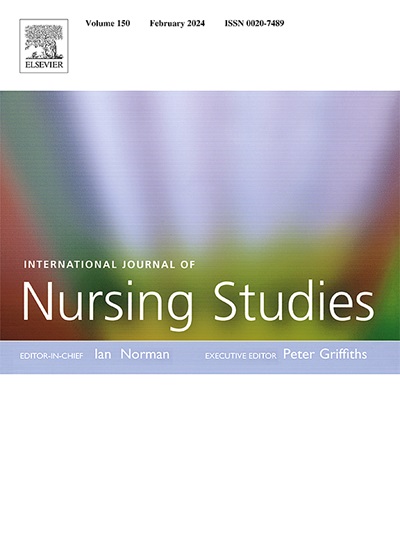有和没有临床决策评估系统的谵妄识别对住院老年人结局的比较效果:整群随机对照试验。
IF 7.5
1区 医学
Q1 NURSING
引用次数: 0
摘要
背景:早期识别谵妄对有效治疗至关重要,但它经常被忽视,导致不良后果。临床决策支持系统可以加强对指南的遵守并改善患者的预后。我们开发了一种基于3分钟诊断访谈的移动临床决策评估工具(3D-DST),用于混乱评估方法定义的谵妄(3D-CAM)。实施3D-DST可以增强医疗保健专业人员对谵妄的识别和对干预措施的依从性,潜在地改善老年人的预后。目的:探讨提高对谵妄的认识是否能改善老年人的临床预后。设计:分组随机对照试验,配对。环境:三级老年医院。参与者:年龄≥65岁的患者。方法:将4个普通病房配对,随机分为干预组(2个病房)和对照组(2个病房)。干预包括由护士使用3D-DST或3D-CAM进行常规谵妄评估,以及由多学科团队进行谵妄预防和干预措施。测量的结果包括谵妄发生率、持续时间、严重程度、住院时间,以及对谵妄评估、预防和治疗方案的依从性。一位训练有素的护理研究员收集了人口统计学、临床特征和主要和次要结果的数据。结果:211例符合条件的患者(干预组106例,对照组105例),其中21例经3D-DST鉴定为谵妄阳性。干预组老年人Charlson合并症指数中位数为1(1-2),对照组为2(1-3),差异有统计学意义(P = 0.032)。干预组护士对谵妄评估的依从性明显高于对照组(73%对31%)。干预组护士谵妄的识别率为89%,对照组为42%。干预组与对照组谵妄持续时间(6例[3-9]比7例[2-14],P = 0.967)、发生率(8.5%比11.4%,P = 0.500)、严重程度(2例[1-3]比2例[1-4],P = 0.891)、住院时间(15例[14-18]比18例[13-22],P = 0.568)差异均无统计学意义。结论:3D-DST增强了护士对谵妄识别的依从性。然而,迫切需要有效的策略来加强多学科合作,提高医疗保健专业人员对谵妄管理的依从性。注册:中国临床试验注册中心,编号:ChiCTR1900028402。本文章由计算机程序翻译,如有差异,请以英文原文为准。
Comparative effectiveness of delirium recognition with and without a clinical decision assessment system on outcomes of hospitalized older adults: Cluster randomized controlled trial
Background
Early recognition of delirium is essential for effective management, but it often goes unrecognized, resulting in adverse outcomes. Clinical decision support systems can enhance adherence to guidelines and improve patient outcomes. We developed a mobile-based clinical decision assessment tool (3D-DST) based on the 3-minute diagnostic interview for confusion assessment method-defined delirium (3D-CAM). Implementing the 3D-DST may enhance delirium recognition and adherence to interventions among healthcare professionals, potentially improving outcomes in older adults.
Objective
To test whether improved recognition of delirium could lead to better clinical outcomes in older adults.
Design
A cluster randomized controlled trial with pair-matching.
Setting
A tertiary geriatric hospital.
Participants
Patients aged ≥ 65 years.
Methods
Four general wards were paired and randomly assigned to the intervention group (two wards) or the control group (two wards). The intervention included routine delirium assessments by nurses using either the 3D-DST or the 3D-CAM, along with delirium prevention and intervention measures carried out by a multidisciplinary team. Outcomes measured included delirium incidence, duration, severity, length of stay, and adherence to the delirium assessment, prevention, and treatment protocol. A trained nursing researcher collected data on demographics, clinical characteristics, and primary and secondary outcomes.
Results
211 eligible patients participated (106 in the intervention group and 105 in the control group), with 21 identified as delirium-positive using the 3D-DST. The median Charlson comorbidity index score among older adults in the intervention group was 1 (1–2), compared to 2 (1–3) in the control group (P = 0.032). Nurses' adherence to delirium assessment was significantly higher in the intervention group than in the control group (73 % vs. 31 %). The recognition rate of delirium among nurses was 89 % in the intervention group and 42 % in the control group. There were no statistically significant differences in delirium duration (6 [3–9] vs. 7 [2–14], P = 0.967), incidence (8.5 % vs. 11.4 %, P = 0.500), severity (2 [1–3] vs. 2 [1–4], P = 0.891) or length of hospital stay (15 [14–18] vs. 18 [13–22], P = 0.568) between the intervention and control groups.
Conclusions
The 3D-DST enhanced adherence to routine delirium recognition by nurses. However, effective strategies are urgently needed to strengthen multidisciplinary collaboration and enhance adherence to delirium management among healthcare professionals.
Registration
Chinese Clinical Trial Registry, Identifier: ChiCTR1900028402.
求助全文
通过发布文献求助,成功后即可免费获取论文全文。
去求助
来源期刊
CiteScore
15.00
自引率
2.50%
发文量
181
审稿时长
21 days
期刊介绍:
The International Journal of Nursing Studies (IJNS) is a highly respected journal that has been publishing original peer-reviewed articles since 1963. It provides a forum for original research and scholarship about health care delivery, organisation, management, workforce, policy, and research methods relevant to nursing, midwifery, and other health related professions. The journal aims to support evidence informed policy and practice by publishing research, systematic and other scholarly reviews, critical discussion, and commentary of the highest standard. The IJNS is indexed in major databases including PubMed, Medline, Thomson Reuters - Science Citation Index, Scopus, Thomson Reuters - Social Science Citation Index, CINAHL, and the BNI (British Nursing Index).

 求助内容:
求助内容: 应助结果提醒方式:
应助结果提醒方式:


